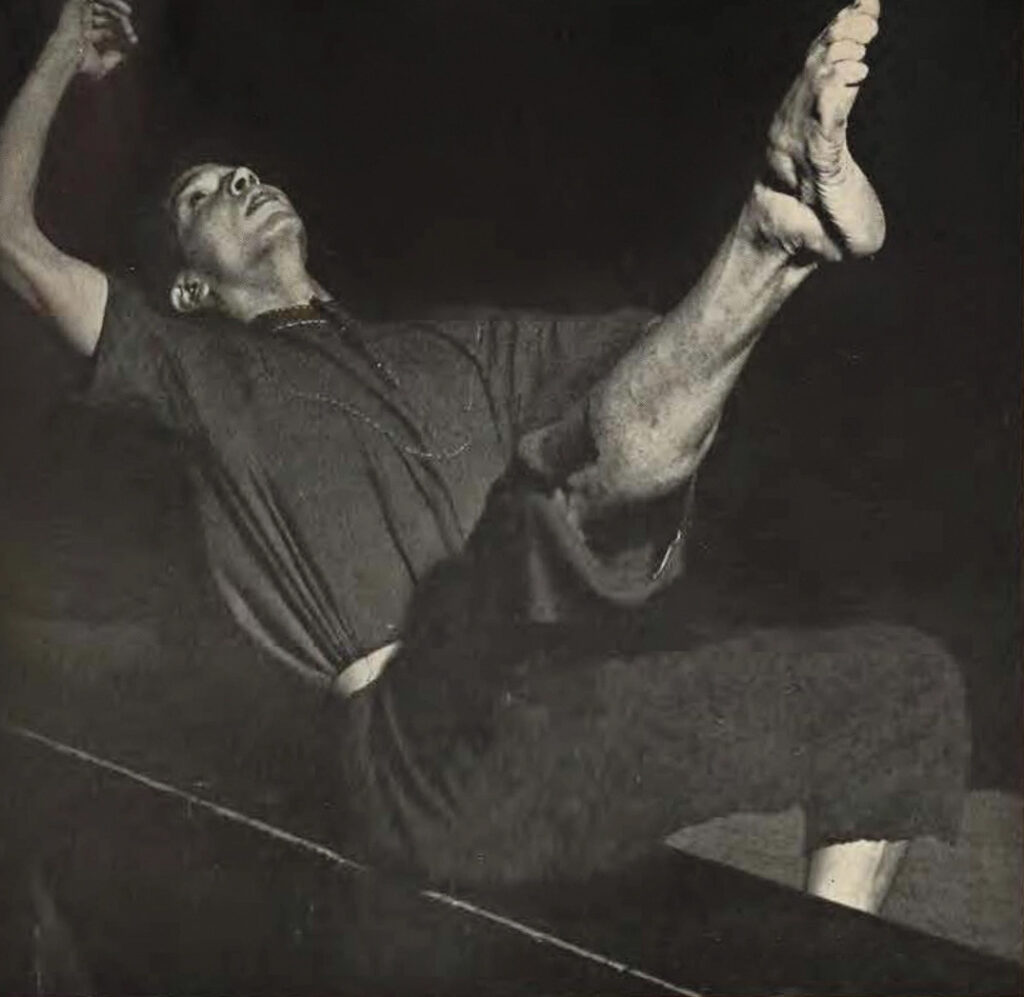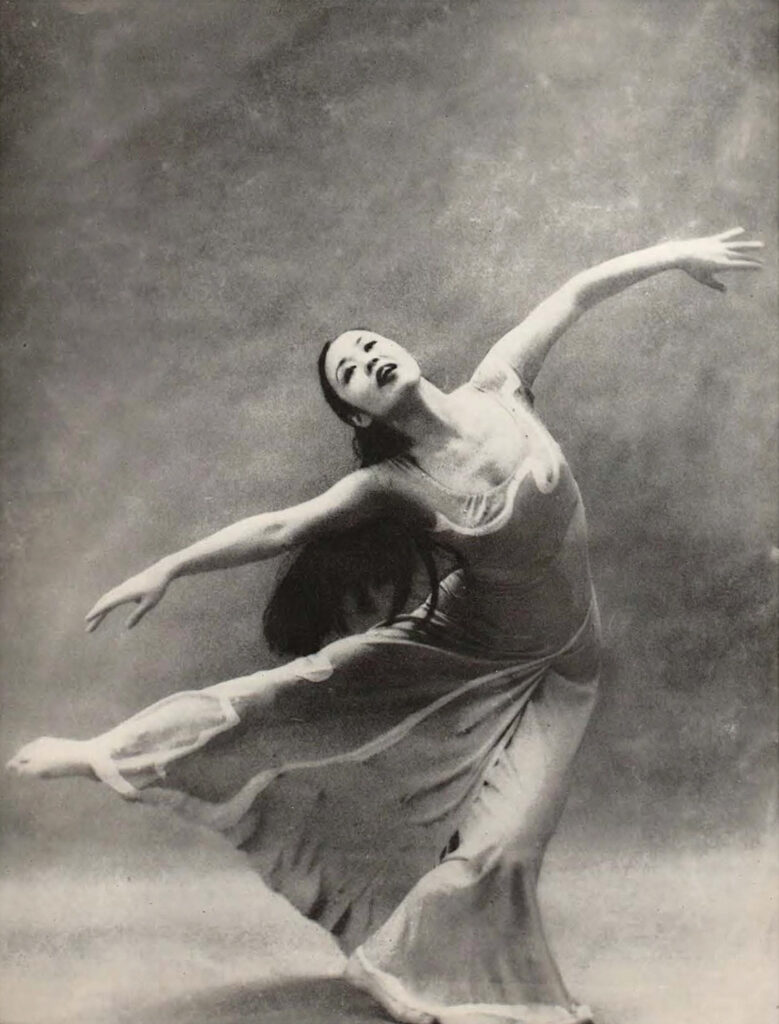This week we’re sharing tributes to all of the 2024 Dance Magazine Award honorees. Founded in 1954, the Dance Magazine Awards have historically only been given to living artists, but in 2023 posthumous honors were added to recognize some of the many artists not given awards during their lifetimes.
For tickets to the awards ceremony on December 2, visit store.dancemedia.com.

Carmen Amaya
Carmen Amaya. Photo from the DM Archives.
Romani musicologist Gonzalo Montaño Peña, writing of the great Carmen Amaya, found her flamenco dancing beyond compare. “She belongs to the select group of chosen artists who do not create art so much as they are themselves works of art,” he wrote.
Born amid the poverty of Barcelona’s Roma community, Amaya began her career as a small child busking on the streets with her guitarist father and dancing in the cafés cantantes and tablaos of her city. Later, she would grow up to light up concert stages and appear in numerous films.
For her time, she cut quite a radical—and controversial—figure. Recognized early on for the electrifying speed and steely assertiveness of her footwork, a styling solely associated with male dancers, she dared to challenge perceptions of women’s stance in flamenco with its focus on the femininity of their lyrical arms and upper bodies. And she dared do all that dressed in neat, sleek trousers like a man.
Upheaval in her native land served to introduce Amaya to a larger world. The Spanish Civil War caught her in the midst of a nation-wide tour, and she fled with her large family first to Lisbon, then Buenos Aires, eventually performing across Latin America. In 1941, American impresario Sol Hurok brought Amaya to Broadway and Carnegie Hall. More touring through the Americas and around Europe established her celebrity, endearing Amaya to everyone from Hollywood royalty to Queen Elizabeth II. She is well remembered for a virtuosity that liberated bailaoras from the frills and softness of traditional roles and handed them new keys to full, expressive power.
Talley Beatty
Louisiana native Talley Beatty, born in 1918, came of creative age during an era of intense segregation, discrimination, and anti-Black violence in the United States. He became one of our most broadly accomplished Black artists in dance.
Beatty’s career in performance and dancemaking, launched by Katherine Dunham and Martha Graham, spanned the concert stage, Broadway theater, film, and television. His work seamlessly united movement techniques, requiring technical proficiency and flair in ballet, modern, jazz dance, and—first influenced by Dunham’s shift of interest from ballet to Caribbean movement—traditions of the African diaspora.
Critics of the time—many concert audiences, as well—expected works rendered in discrete styles. But Beatty, like the renowned Alvin Ailey, began to reeducate their eyes. Applying the many disciplines at hand to pieces like Southern Landscape (1947), Road of the Phoebe Snow (1959), and Come and Get the Beauty of it Hot (1960), he could hone the dancing body to pliant expression and convey the truth of Black lives in rural and urban America, lives of determination, struggle, grief, resilience, and joy.
 Talley Beatty. Photo from the DM Archives.
Talley Beatty. Photo from the DM Archives.
Beatty’s commitment to the body as an archive of Black experience and emotion rings clear for us today as the honest study of Black history in America has become a political flashpoint. In his famous solo, “Mourner’s Bench,” from Southern Landscape, the dancer professes faith in “a balm in Gilead to make the wounded whole.” Beatty’s life and work offer testimony that the arts themselves could and still can serve as courageous witness and balm for a people and, perhaps, our nation’s still imperfect union.
Yuriko
Born to Japanese immigrants in California, dancer Yuriko Kikuchi, who went by Yuriko professionally, lived some of the best and the worst experiences of being American during her remarkable 102 years. At 3 years old, she lost her father and two siblings to the 1918 flu pandemic. To save Yuriko’s life, her mother sent her for temporary shelter with relatives in Japan. She spent her formative years and adolescence shuttling between nations while training in ballet and modern dance.
During World War II, President Roosevelt ordered Japanese Americans, like Yuriko and her remaining family, to be forcibly removed from their homes and incarcerated in detention camps. Despite this injustice, Yuriko found a way to maintain her passion for dance, and became noted for her skill at teaching the art to fellow inmates of California’s transitional Tulare Assembly Center and Arizona’s Gila River Relocation Center.
 Yuriko. Photo from the DM Archives.
Yuriko. Photo from the DM Archives.
Upon her release, Yuriko made her way to New York City, starting work as a seamstress before being warmly welcomed by Martha Graham as Graham’s first dancer of color. She rose to principal status, noted for her lyrical embodiment of Graham’s formidable technique. Yuriko premiered roles in Graham’s Appalachian Spring, Cave of the Heart, Clytemnestra, Embattled Garden, and other classics, and portrayed the Virgin Mary, a role originated by Graham, in the 1964 revival of Primitive Mysteries. Cast as Eliza in the 1951 Broadway premiere of The King and I, she later joined the original cast of Flower Drum Song, which featured Asian performers in its leading roles.
Yuriko also built her own troupe, taught in the Graham school, served as rehearsal director, and formed the secondary Martha Graham Ensemble. As Graham’s champion, she preserved and shared the master choreographer’s brilliance with coming generations of dancers within and outside of the Graham company, and was critically acclaimed for restaging Appalachian Spring for The Joffrey Ballet in 2000.
Always professing gratitude, Yuriko once told a Japanese interviewer that “dance is living…survival….it saved my life.” She was an artist intent on giving back and celebrating our shared humanity.
Old Iolani
With affection and respect, they called her Aunty ‘Io.
In childhood, her given name, Harriet Lanihau Makekau, was changed to ‘Iolani (“soaring like a hawk” or “royal hawk”), a special name believed to have healed her once-ailing eyes. ‘Iolani Luahine carried the spiritual power of hula kahiko—the dancing, singing, chanting, and storytelling practices of ancient, native Hawai‘i. She was a direct descendant of hula’s own royalty, dancers from the court of King Kalākaua and Queen Lili‘uokalani, Hawai‘i’s last sovereign.
The people of ancient Hawai‘i studied and revered the ways of sea, sky, weather, land, and all living things, sharing this sacred knowledge through movement, sound, and mythic tales. Each account of Luahine’s performances speaks of her uncanny, mystical connection to and channeling of the natural world. First instructed in the arts by her great aunt Julia Keahi Luahine and later by Mary Kawena Pukui, Luahine became one of hula kahiko’s foremost practitioners, teachers, and conservators. Her approach was uncompromising. In a 1994 video, her niece Hoakalei Kamau‘u recalls Luahine declaring, “Our ancient hula doesn’t belong in a bar, or anywhere else.”
 ‘Iolani Luahine. Photo from the DM Archives.
‘Iolani Luahine. Photo from the DM Archives.
Luahine’s teaching requires us to reflect on the many misperceptions about native Hawaiian culture spread by the entertainment industry, and how that culture has been commodified for the tourist dollar. Rejecting decorative, often sexualized, ultimately shallow displays, Luahine made it her mission to reach back to the animistic and community-oriented origins of hula and uphold its meaning for contemporary students and audiences. This was her gift to the future and one that can inspire all of us to rediscover what we value, what truly nourishes and sustains us.
Raven Wilkinson
It might shock today’s dance students to learn of a time when a Black ballerina had to be safely escorted by male colleagues to and from theaters, lighten her skin tone with makeup, and find tour accommodations accepting of her race. But Raven Wilkinson, the first Black woman to sign with Ballet Russe de Monte Carlo, survived America’s Jim Crow era and direct threats from the Ku Klux Klan. She would achieve a laudable, pioneering career with Ballet Russe, Dutch National Ballet, and New York City Opera, though her path was never easy.
 Raven Wilkinson. Photo courtesy Wilkinson.
Raven Wilkinson. Photo courtesy Wilkinson.
Turned away by Ballet Russe more than once—the troupe feared the risk of bringing her on tours through Southern states—Wilkinson finally got in, reportedly, on the strength of an endorsement by ballet master Frederic Franklin. However, despite sure talent and desire, Wilkinson faced the headwinds of an America still in the grip of segregation. After six years, she left Ballet Russe in search of better opportunities, but New York City’s major ballet leaders showed either no interest or outright hostility. Discouraged, Wilkinson chose to leave dance altogether and, for a short time, joined a convent.
When Wilkinson regained determination, a colleague invited her to try a more accepting Europe and apply to Dutch National Ballet. She graced that troupe from 1967–73 before reaching mandatory retirement age. Returning to the States, she joined New York City Opera as a dancer and, later, an actress.
A youthful Wilkinson once thrilled to watch Black ballerina Janet Collins onstage. Perhaps she remembered those early days as she tracked Black ballerina Misty Copeland’s rise to the rank of principal at American Ballet Theatre, a first for this major company. The two artists became close friends and, when Copeland received her 2014 Dance Magazine Award, it was Wilkinson who was on hand to make the proud presentation.
Michaela Mabinty DePrince
Watching Michaela Mabinty DePrince dance, it’s hard to reconcile how such radiance could surface from a soul once weighted by rejection and loss, a child forced to witness horrific violence. From Mabinty Bangura, abandoned orphan in war-torn Sierra Leone, to accomplished ballerina, author, public speaker, and humanitarian, DePrince won our hearts with her determined alchemy of discipline and hope.
 Michaela Mabinty DePrince. Photo by Liza Voll.
Michaela Mabinty DePrince. Photo by Liza Voll.
Not many dancers get to recount their lives in TEDx Talks and through profiles in everything from The New York Times to Teen Vogue. But while DePrince took pains to make sure no one mistook her biography for a fairy tale, she did seem preternaturally guided. Didn’t a fortuitous wind carry an old Dance Magazine cover to the gate of her orphanage, displaying a ballerina? (Yes, white, smiling, bedecked in pink.) And didn’t her adoptive parents, Americans Charles and Elaine DePrince, welcome not one but two of the orphanage’s least-favored girls—both named Mabinty and as close as sisters?
Renamed Michaela, DePrince would go on to train hard and shine at the Youth America Grand Prix, as shown in the 2011 documentary First Position. Soon she would become Dance Theatre of Harlem’s youngest performer, eventually dancing with Dutch National Ballet and Boston Ballet. She would appear in a Beyoncé video and see her biography slated for film adaptation, with Madonna to direct.
But we would lose this bright star, this year, at age 29. The news plunged many of us into shock and grief. How do we make sense of a fate so unimaginably cruel? By remembering DePrince’s dedication to the beauty of dance and, through her advocacy, the potential beauty of a world made safer and more empowering for all children.





GIPHY App Key not set. Please check settings